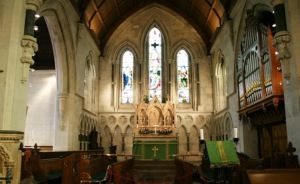Opinion
‘Mere te’ Vicar?: Remembrance, rebellion and reconciliation
Darren McCallig
This article is more than 9 years old.

The pillars, pews and pulpit of integration (photo: St-albans.dk)
At St Alban’s Anglican Church (known affectionately by many locals as ‘the English Church’) we are preparing for one of the most significant events of the year: the annual Remembrance Day service on Sunday 13 November at 10:30.
Remembrance for all
The ceremony is, in many ways, typical of the Remembrance Day services one finds in many countries throughout the world. We will remember those who died in conflict and war – especially the two terrible World Wars of the 20th century – and pray for peace.
The well-known words of the Ode of Remembrance will be read (“They shall grow not old, as we that are left grow old …”), followed by the Last Post, then two minutes silence, and finally the bugler will play the ‘Reveille’.
However, while the ritual may seem unchanged for decades, the congregation at St Alban’s continues to grow and evolve. There are now 27 different nationalities worshipping regularly at the church – English is our common language, not our shared nationality.
For example, I, the priest, am Irish, the organist is Norwegian and one of the churchwardens is a Kiwi. On any given Sunday you will find people from every part of the globe in the pews – Iranians and Indians, Germans and Ghanaians, Americans and Australians – all of them coming together as one family of faith.
Recalling the brave
This changing context will be reflected in this year’s Remembrance Day service. For the first time in the church’s long history, one of the lessons at the November ceremony will be read by the Irish ambassador to Denmark, Cliona Manahan. It’s worth recalling why this is so significant.
2016 is a landmark year in the history of my home country of Ireland. It is the centenary of two events that shaped the course of recent Irish history: the 1916 Easter Rising and the Battle of the Somme.
The Easter Rising – an armed insurrection against British rule – was the first step towards independence for most of the island of Ireland. In the Republic of Ireland the leaders of the 1916 rebellion came to be regarded as national heroes.
The Battle of the Somme was an equally seismic event.
Not only was it one of the bloodiest battles of the First World War, but over 3,500 Irish soldiers were killed fighting for the British Army against the Germans, and many more were wounded. Indeed, 2,000 men from what’s now known as Northern Ireland died in the first few hours of fighting alone – a catastrophe that became seared into local folk memory.
Reconciliation a century on
However, they – and the almost 50,000 other Irish who died in British uniforms – were largely written-out of the subsequent ‘official’ history of the Republic.
As Irish President Mary McAleese said in 1998, the memory of these men “fell victim to a war for independence at home in Ireland. In the history of conflict that has blighted my homeland for generations, respect for the memory of one set of heroes was often at the expense of respect for the memory of the other.”
My hope is that this year’s Service of Remembrance will also be a moment of reconciliation. By including in our remembering a group who have often been ignored, we will be committing ourselves to widening the circle of our remembrance – an imperative for any truly multinational and truly Christian community.

About
Darren McCallig
As the Irish-born vicar of St Alban’s Anglican Church, Darren has a congregation of over two dozen different nationalities (st-albans.dk). Celebrating diversity and building inclusive community are his divine aspirations. And yes – he enjoys a nice cup of tea.










































